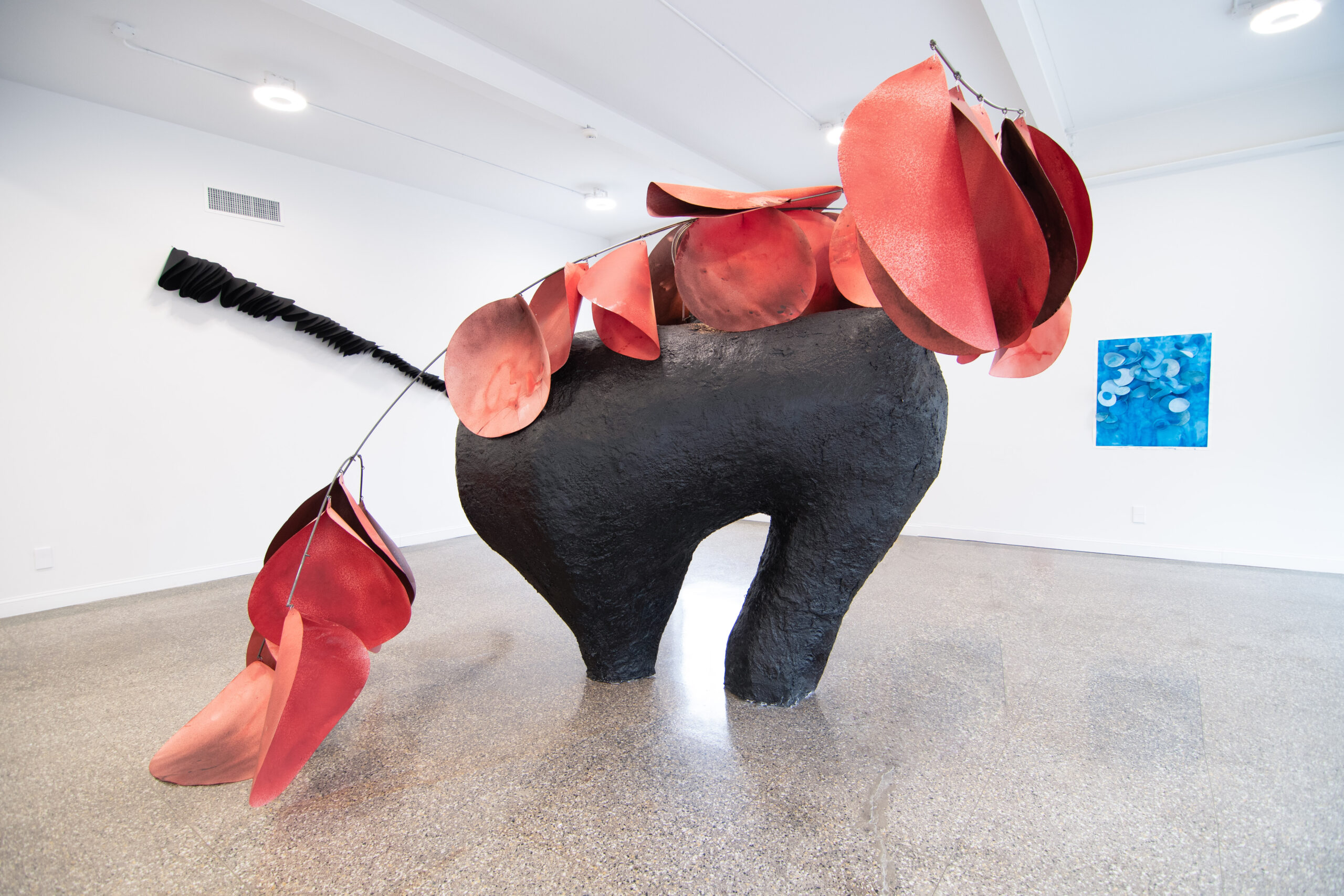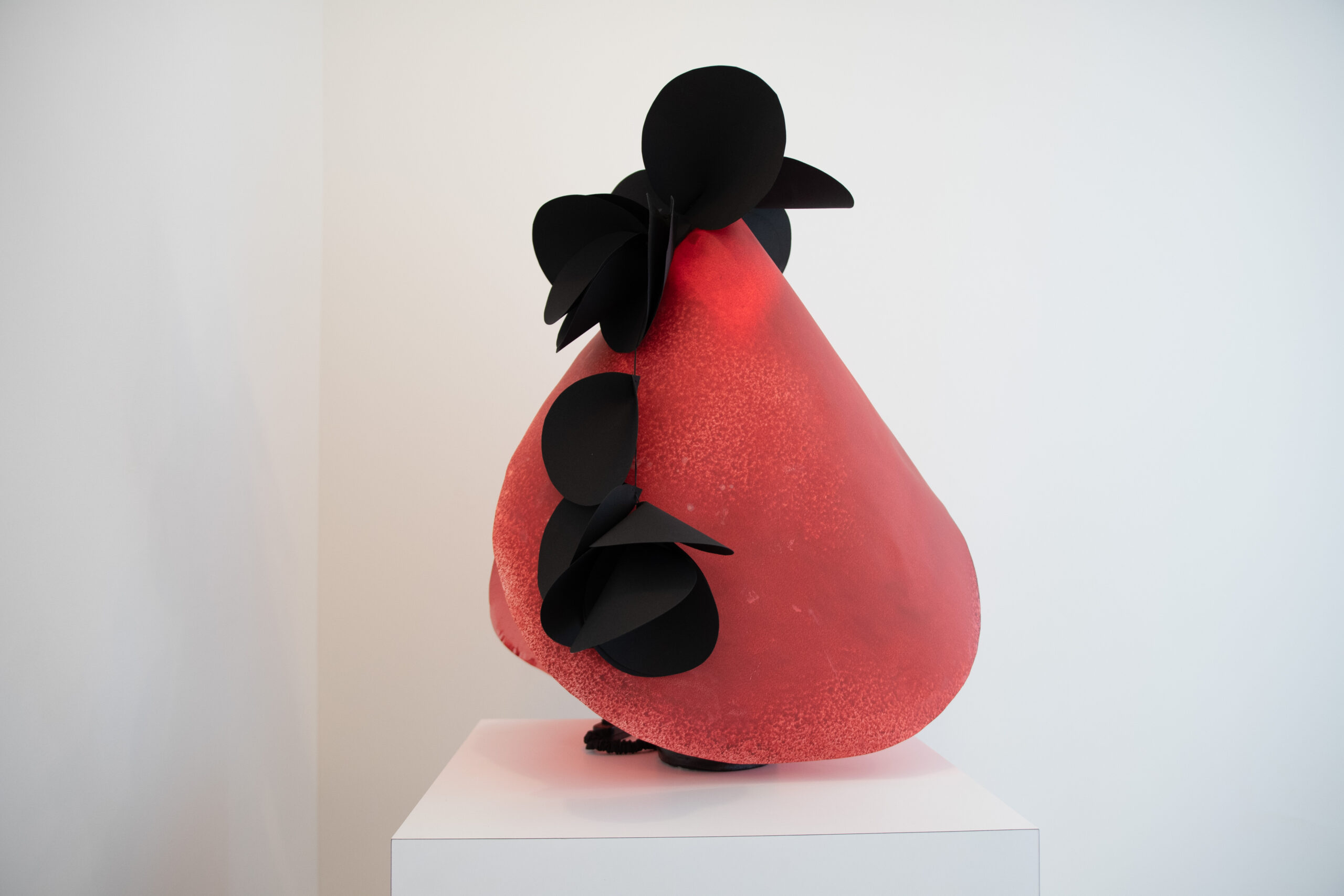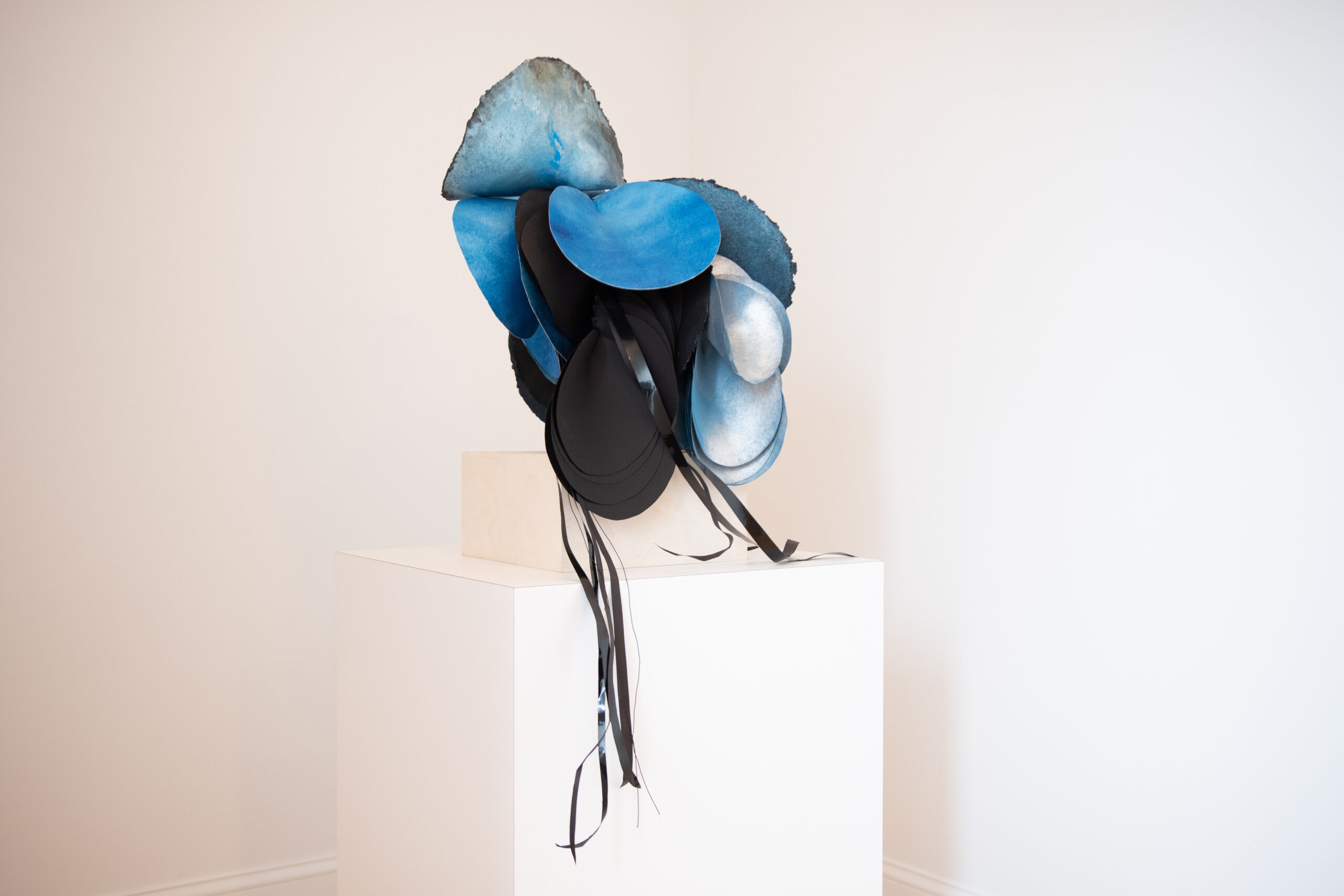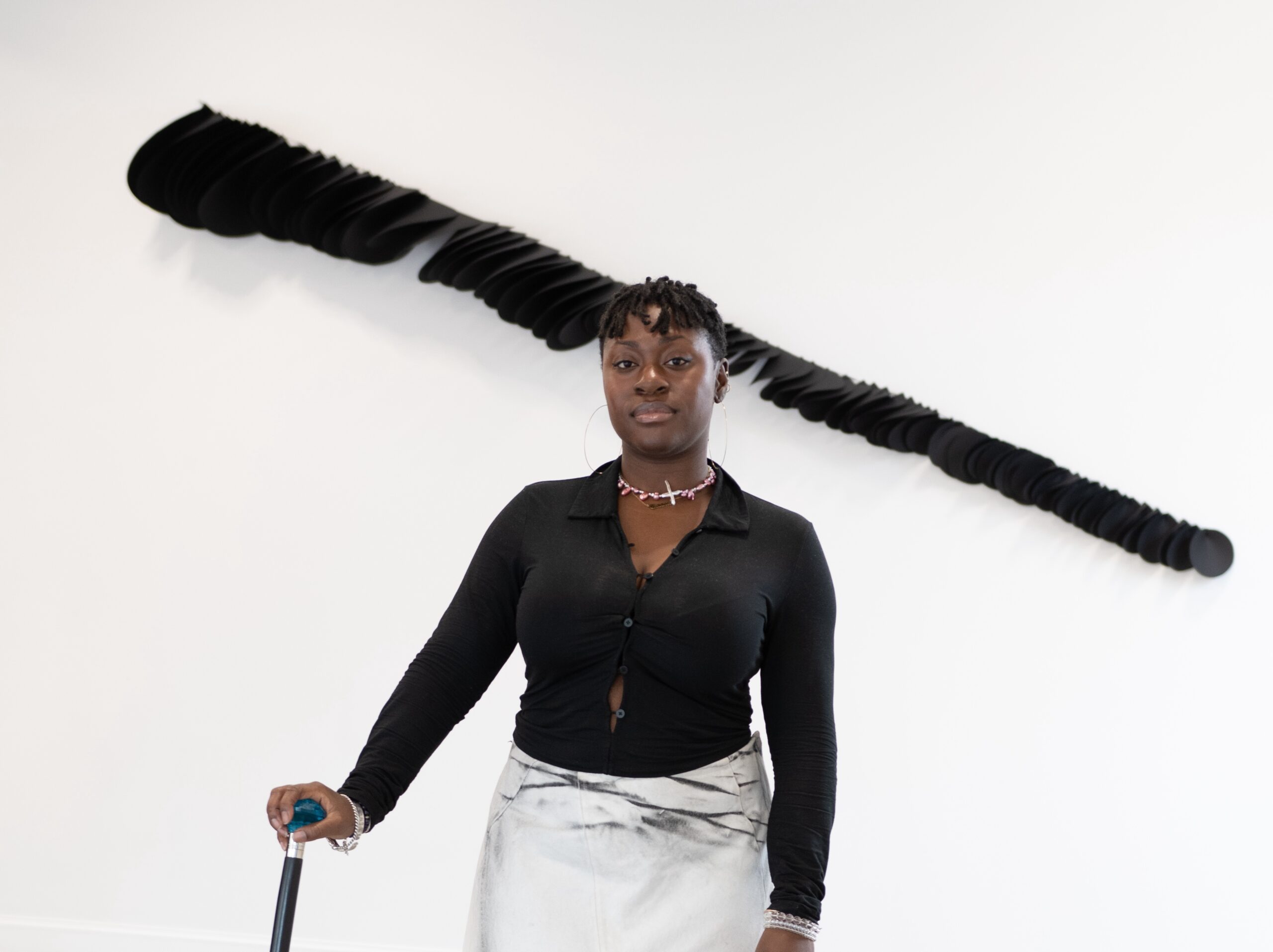
Catskill, NY – The overcast evening is interrupted by momentary flash rain, which makes for a glossy finish on the sidewalks of Main Street. Cars are halting to a slow roll as they wind around the corner, trying to make out the considerably evasive shape inside the gallery. “Is it an elephant?” a couple whispers while peering through the window. They’ve come to see Karina Sharif’s inaugural solo show, A Dream Embodied, at the emerging Gallery 495.
Karina Sharif is a multidisciplinary paper artist born in Boston and based in Brooklyn. Her practice is a delicate infringement of our expectations for materials, especially paper. Sharif employs world-building and challenges spatial occupancy while highlighting multitudes of divine Black Femmehood. Enfolded by themes of rest, adornment, spatial impact and sensory elements, her work is crafted with intentionality, always considering how the work will interact with its surroundings. While Sharif’s practice is coded with methodical, laborious construction, the work itself is meant to be a manifestation of restorative restitution for her viewers.

To address the mistaken elephant in the room, Sharif’s largest sculpture, A Warm Embrace, Obsidian Incarnate, spans its arms outward and above, grounded by its underbelly, a black plaster mass with a hollow-arched centre. The structure supports an engulfing Calder-esque mobile of rosy orange paper petals. Its massive scale and unexpected shape challenge visitors to circle around its overhanging limbs – viewers are left inquisitive, awe-struck and cautious not to bump into it while being drawn in. Sharif is conceiving a simple yet immersive environment and exploring the intersection between all that is adored and architectural. Meditative by nature, the sculpture traverses what it looks like for the Black-Femme narrative to occupy literal and figurative space.
The opening reception peaked when the gallery lights abruptly shut off, and visitors learned something they hadn’t yet known about the sculpture. Atop the plaster mass and hidden behind paper petals shined a single light bulb, hushed in its luminescence. Without any instruction at all, the crowd intuitively gathered in a circle around A Warm Embrace, Obsidian Incarnate, relishing in its glory, almost as if to join hands and sing together. In the room populated by faceless collective and bulbous silhouette shadows spread across the gallery’s interior, the sculpture suddenly felt omnipresent, sacred even.


The sensory-deprived environment led to a heightened viewing experience and served as a perfect reminder for viewers to look beyond the seemingly finite sculpture before them. What had once looked like an elephant or mobile attached to a plaster form had been transformed into an ominous extension of the ground. It is also a caster of shadows, a rebirthed mutation, and a light source. While the lights were cut for only a minute or two, it was an a-ha moment – the sculpture was tethered to a singular perspective and, as a result, ultimately confined. This experience felt like a perfect supporting metaphor for Sharif’s own exploration of the ways that Black-Femmes take up space. With the sculpture now expanded in the gallery tenfold, Sharif implies a widespread amplification and impact of the Black-Femme narrative. Historically, it is underpraised, but at its core, it is all-encompassing and the catalyst of much of America and the culture as we know it.
What we’re taught about art is, often, it’s the idea behind it just as much as its physical presentation. While Shairf’s work is visually stunning, sometimes, you need to turn off the lights in order to understand how to see.
I can’t ignore the historical significance linked to paper in Sharif’s work – or, as renowned textile artist Anni Alber would put it, the “material as metaphor”. Sharif’s work pays homage to traditional domestic practices while reworking them into a contemporary narrative. Historically, female artists have been keen to explore the prospects of paper and textiles to acknowledge their relationship to the troubling history of their art. Other artists such as Jen Aitken, Mary Evans, and Elisabetta Di Maggio implement the fibrous material in their practice in different but equally as innovative ways as Karina Sharif. Naturally, the use of paper evokes a repetitive and tedious task that tributes time-honoured craft and the unseen, at-home labour of women. By intuitively choosing paper, Sharif is reckoning with this dialogue and evolving it with her own practice.

Sharif’s practice also integrates wearable works that transcend the confines of traditional sculpture. These works occupy space and bodies with intentional folds and embellishments, straddling between abstraction and accessory. Each fragile paper stem draped around a limb, hip or fingertip engages with the figure in a way that utilises storytelling. They’re structural by nature but acknowledge ancient fashion trends which centralised exaggerated, non-functional accessories in the name of beauty and celebration. The sculptures are sophisticated and playful, exhibiting versatility in the fine art space and also operating as wearable garments. The imagery of Black-Femme bodies wearing the works is immortalised by photography and evokes a sense of adornment and protection.

A Dream Embodied, fulfills its namesake – while the show title represents one’s affirmations coming to fruition, the sculptures lend themselves to tangible embodiments; each is a manifestation of a different energy or personality. If you walk through a back door in the gallery, you’re met with a long, turning hall that leads to an isolated space with three of Sharif’s smaller sculptures and some of her strongest work, in my opinion. It’s the final stop in the exhibit. One sculpture is of cool, pearlescent blues and greys with long, black, draped finishes that mirror the likeness of hair hanging over one’s shoulders. It faces a plump, warm lamp with black, puffy accents – the light behind its red-hued paper tenderly dims the corner. To the right is a white, whimsical shape, flaccidly folding over itself, again and again, to remind viewers that, after all, it is made of paper and a distant relative to the trees that share its horizon beyond the window. Each of them embodies their own spirit – each is alive in conversation.
Masquerading behind delicate paper sculptures, Sharif explores a deep history of craft, beauty and fashion and praises the narratives of the Black-Femmes before her, amongst her and to come. Folded and tethered to paper physicality, the works substitute pages of written context and speak for themselves. Just as the elephant in the room is dissolved, the materiality of paper undergoes a metamorphosis at the hands of Karina Sharif.
Written by Gwyneth Giller






